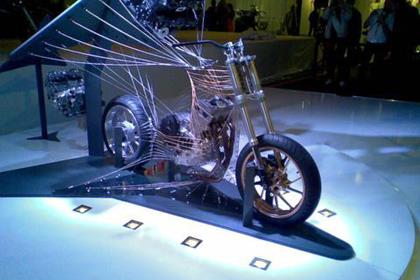Yamaha planning 'crossplane' dynasty
As well as its promised ‘crossplane’ three-cylinder engine Yamaha is preparing a -parallel-twin and further variations on the R1’s four-cylinder crossplane motor to create an entire family of characterful new motors.
With its three-cylinder concept engine, revealed at last autumn’s round of bike shows, Yamaha’s intention was to carry over the “character of the crossplane concept featured on the M1 and R1 engines” and create an engine that markedly differentiated itself from the horde of inline-four-cylinder rivals.
To add to that differentiation, the production version of the engine will carry its own name and logo: ‘CP3’.
Documents lodged with trademark offices in Europe, America and Australia all match, with Yamaha applying for the ‘CP3’ trademark to apply to “engines for motorcycles”. It doesn’t take a huge leap to work out that the initials stand for “Cross Plane Triple”.
It’s unusual to see engines getting their own names, with Ducati being the only company to regularly brand its motors with protected trademarks – using terms like ‘Desmo’, ‘Desmoquattro’ and ‘Superquadro’.
While CP3 sounds less like a pizza topping and more like a Star Wars robot, the step shows how Yamaha wants to add character to the motor.
Intriguingly, further trademark applications filed at the same time show that Yamaha isn’t planning to stop with the triple: it’s also registered ‘CP2’ and ‘CP4’ – presumably for twin and four-cylinder engines based on the same thinking.
Crossplane, a refresher…
In a ‘normal’ inline four-cylinder engine, the crankshaft throws are 180° apart. That means that two pistons go up in unison while the other two go down. It also means that twice in every revolution there’s an instant when all four pistons simultaneously come to a dead stop. Two at top dead centre (TDC), two at bottom dead centre (BDC).
Just a quarter of a revolution later (and at 10,000rpm that means 0.0015 seconds) all four pistons and their con-rods are travelling at full speed (around 60mph at 10,000rpm on a modern 1000cc four) before coming to a complete halt again.
So while it might seem silky smooth from the rider’s seat, the forces are oscillating wildly. This change in ‘inertial torque’ is sometimes blamed for causing wheelspin on inline fours.
A crossplane inline four like the R1’s solves the problem. Instead of 180° crank throws it has an X-shaped crank with 90° between the throws. That means that when one piston is stationary at TDC and another is stopped at BDC, the remaining two are hurtling at top speed in the middle of their stroke (one going up, the other down).
As they decelerate, the other two pistons are being accelerated. The end result is that the inertial torque changes cancel each other out. A 90° V4 achieves the same result, and you only need to look at MotoGP to see that it’s been years since a race was won by anything other than a V4 or a crossplane inline four.
So what’s Yamaha’s CP3 engine all about?
You can’t overstate the importance of the new triple to Yamaha’s plans. While we’re still waiting for confirmation on the details of the first bike it will appear in, it’s already certain that triples will appear in multiple capacities and several different machines.
Yamaha’s says that “this advanced new light, slim and compact three-cylinder engine will shape Yamaha’s future motorcycle line-up.”
Yamaha is careful to steer clear of actually calling the triple a ‘crossplane’ design. While the crank throws of the R1’s four-cylinder crossplane engine form a true ‘X’ when looking at the crankshaft, end-on, that’s not really possible on an engine with less than four crank throws, like a triple or a twin.
Instead Yamaha refers to the triple as being “inspired by the linear driving power of the crossplane concept” and saying that the “crossplane concept of eliminating unwanted inertial torque… forms the basis of the new three-cylinder Yamaha engine.”
Exactly how the firm has achieved that is still a matter for debate, and will no doubt remain so until the final technical details are revealed later this year (see right).
What about CP2 and CP4?
Yamaha hasn’t shown a ‘crossplane-inspired’ twin yet, but the CP2 trademark suggests a motor is in the works and Yamaha already has a couple of engines that could form its basis.
Following the crossplane logic, the CP2 would be an inline twin with a 270° crankshaft to mimic the smooth torque delivery of a 90° V-twin. And that’s something the firm has already created, using 270° twins on both the ageing TDM900 and the relatively new XTZ1200 Super Tenere.
The 270° crank on these twins does the same job as the R1’s crossplane crank, reducing the inertial torque to provide a smoother power delivery.
The CP4 trademark is presumably aimed at the existing R1’s four-cylinder crossplane engine and future motors. But Yamaha might be concentrating on the triples and twins, because while it has trademarked the ‘CP4’ acronym it hasn’t trademarked a logo to go with it, as it has for the CP3 and CP2.


